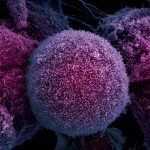Lien vers Pubmed [PMID] – 24466051
PLoS ONE 2014;9(1):e86358
Ku70 and Ku80 form a heterodimer called Ku that forms a holoenzyme with DNA dependent-protein kinase catalytic subunit (DNA-PKCS) to repair DNA double strand breaks (DSBs) through the nonhomologous end joining (NHEJ) pathway. As expected mutating these genes in mice caused a similar DSB repair-defective phenotype. However, ku70(-/-) cells and ku80(-/-) cells also appeared to have a defect in base excision repair (BER). BER corrects base lesions, apurinic/apyrimidinic (AP) sites and single stand breaks (SSBs) utilizing a variety of proteins including glycosylases, AP endonuclease 1 (APE1) and DNA Polymerase β (Pol β). In addition, deleting Ku70 was not equivalent to deleting Ku80 in cells and mice. Therefore, we hypothesized that free Ku70 (not bound to Ku80) and/or free Ku80 (not bound to Ku70) possessed activity that influenced BER. To further test this hypothesis we performed two general sets of experiments. The first set showed that deleting either Ku70 or Ku80 caused an NHEJ-independent defect. We found ku80(-/-) mice had a shorter life span than dna-pkcs(-/-) mice demonstrating a phenotype that was greater than deleting the holoenzyme. We also found Ku70-deletion induced a p53 response that reduced the level of small mutations in the brain suggesting defective BER. We further confirmed that Ku80-deletion impaired BER via a mechanism that was not epistatic to Pol β. The second set of experiments showed that free Ku70 and free Ku80 could influence BER. We observed that deletion of either Ku70 or Ku80, but not both, increased sensitivity of cells to CRT0044876 (CRT), an agent that interferes with APE1. In addition, free Ku70 and free Ku80 bound to AP sites and in the case of Ku70 inhibited APE1 activity. These observations support a novel role for free Ku70 and free Ku80 in altering BER.

